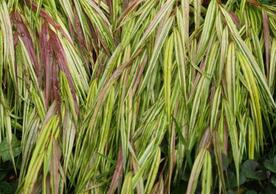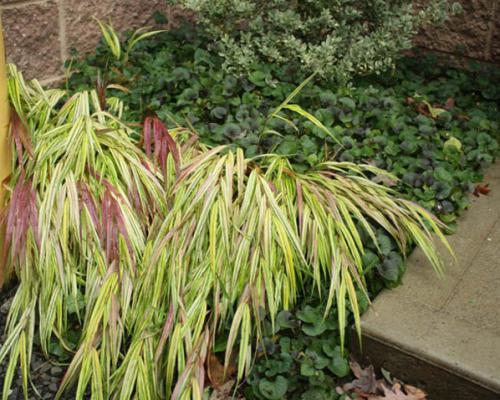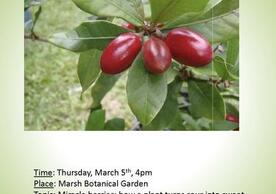Hakonechloa macra cultivars
For those of you living in the New Haven/southern Connecticut area, I’d like you to add the following items to your burgeoning social/gardening calendars. On Saturday, October 6, starting at 7:30, we will be presenting folk music, compliments of Kath Bloom and Ed Askew, two locally-grown folk musicians. We are proud to join with Intercambio, as partners in presenting this evening of entertainment.
On Saturday October 20, time to be announced, we will be doing a tree walk here at the garden. We will be focusing on fall coloration. Over my short nine years of gardening here, I have planted many species of mostly woody (but not all) plants that have some fall interest, be it color, berries or form. So please join me and volunteer John Cox for an hour’s stroll about the garden that morning. I will announce the specific time on the web-site and in next week’s column.
New England is rightfully known for its fall color, with the sugar maples taking the lead, but augmented by sweet gum, ash, oak and others. Then there are a whole list of native shrubs that provide autumn raiment, including Itea, Fothergilla, Clethra and others. When you add in the long list of ‘exotic’ plants, from other biomes and continents, you can easily plan a whole landscape around fall color.
Not all the plants that exhibit leaf coloration in fall are woody. Many herbaceous perennials provide at least some change, like Asparagus, Eastern Bluestar and many of the grasses, notably the Switch Grasses. The grass family (Poaceae) has many sub-families and tribes, covering such divergent plants as corn, rice, bluegrass, bamboo and our plant, Japanese Forest Grass.
It is in the subfamily Arundinoideae, which sounds like an affliction from drinking the wrong water in a foreign land, but it is actually a group of about fifty or sixty genera, including pampas grass, the giant reed and common reed. It is postulated by some that this subfamily may have been the common ancestor in evolutionary history of all grasses.
The genus name is one of those wonderful lingual hybrids that fascinate: Hakone is a town and in previous eras, a district in southwestern Japan, not far from Mount Fuji. It has two huge mountains of its own and plentiful hot springs, making it a favorite for stressed out denizens of Tokyo as well as a draw for tourists of all nationalities. With geysers, mountain views and hiking, an important Shinto shrine and the Hakone Botanical Garden of Wetlands, it sounds like Yale just might need to send the garden manager on a trip for some deep background and outreach. The other part of the genus name comes from the Greek word ‘chloa,’ for grass.
This is one of the few grasses that prefer shade, which makes it ideal for brightening up the shade garden. The straight species H. macra, is decidedly and emphatically very green in the leaf. The leaves are strap-like and very similar to Chasmanthium. But in the many selected varieties, you can find golden yellow, white and chartreuse with some pink and other colors mixed. When the days shorten into fall, the leaf coloration can turn quite red, with gold, orange and other colors mixed in. The leaves tend to hang around most of the winter, finally looking rather dreary. They will let go of them eventually, but it’s best to be proactive about removing them. Sheer them as you would Liriope in late winter or early spring.
As for culture, they do prefer shade, and good soil moisture. Although they will tolerate some drought and some sun, the combination would not be salubrious. These 18-30 inch high plants will grow taller depending on soil fertility, but average is just fine with them. They are hardy to Zone 5 USDA, so you will have no problem growing them around these parts.
For livening up the shady corner, underplanting some of the Ericaceous plantings, as a border for a woodland path and also for use in the cutting garden, Hakenochloa is deservedly a popular plant among the gliterati of the gardening world. It is available widely, even in big box stores. But of course I remind my readers that the small family-owned nurseries are generally where you find knowledgeable and friendly staff, sustainable practices and often locally-grown plants. So I may be preaching to the choir on this one, but go to the place where they just might trade you some plants for your homemade apricot preserves or your collection of 78’s from the early jazz era. Everybody will be better off.
As always, your gardening friend, Eric
Top Photo: The pink-to-red fall color is beginning to show, highlighted nicely by the green-gold variegated foliage of the growing season. Hardy even with ice, snow and salt thrown onto it from our front stoop, this plant is a workhorse in the shade garden.
Bottom Photo: Japanese Forest Grass growing near our entrance, with a variegated Holly behind, underplanted with Wood Violet. This combination is working out well for us, with all four seasons covered with at least SOMEthing showing interest.



